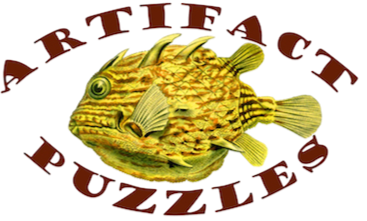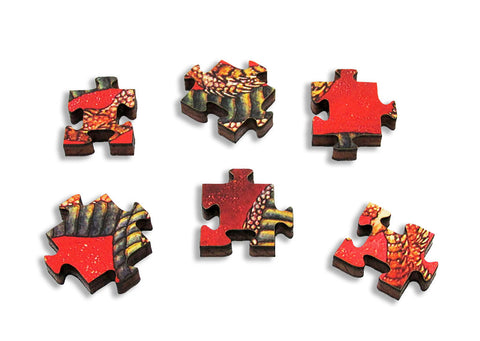
Here's a visual dictionary (though not in alphabetical order) with some common wooden jigsaw puzzle terms, and some not-so-common ones that we find helpful!
Are we missing terms you'd like us to add? Let us know in the comments below!
Whimsy Piece: any piece shaped like something, like this cupid-shaped piece in Renoncules:
Anti-Whimsy Piece: any piece next to a whimsy piece. There are 7 Anti-whimsies surrounding the cupid above. Anti-whimsies are often easy to spot when you are puzzling. as they look like they should go next to a whimsy piece! A well-designed puzzle will have subtle anti-whimsy pieces.
Example usage: "I think this anti-whimsy goes in the mouth of that alligator whimsy, where did we put that?"
Multi-piece Whimsy: when 2 or more puzzle pieces together form something recognizable, like the elephant painting in our Migration of Knowledge:
Irregular edge: any edge that is not straight, like the Kraken:
Decorative edge: any edge that looks particularly decorative, often with a repeated pattern or curlicues, like Monet Springtime:
Drop-outs: pieces left-out on purpose, to highlight or decorate the puzzle. Often you'll see drop-outs used to make a pretty decorative edge. Fabric Owls has a lot of drop-outs:
V-shaped Edge Piece: an edge piece that hits the edge in a point, making it hard to sort-out as an edge piece, like this edge piece in our Haeckel Hummingbirds:
Split Corner Piece: a corner piece split into two pieces in a way that makes it hard to spot it as a corner piece, like this corner in our Haeckel Hummingbirds:
Knob Connectors: the basic standard connector shape that you usually see on cardboard puzzles and on lots of wooden jigsaw puzzles too. Our Hokusai Dragon puzzle has knob connectors:
Non-unique Connectors: this means that most of the connectors are exactly the same. Our Hokusai Dragon puzzle has non-unique knob connectors. We only make puzzles with non-unique connectors when there is a lot of high-res image detail so you can figure out which pieces should go together.
Fancy Knob Connectors / Bannister-top Connectors: The basic knob connector shape can be made quite fancy. Our Edward Hopper Nighthawks puzzle has these fancy knob connectors we call bannister connectors:
Earlet connectors: Probably the most common connector shape after knob connectors for wooden jigsaw puzzles is earlet connectors, which, uh, look like ears with two lobes, like these from Bonnard Under The Tree:
T-shaped Connectors: Another connector shape is T-connectors, like in Chinatown:
Whimsical Connectors / Animal-head Connectors: Like whimsy pieces, connectors can also be shaped like cat heads, duck heads, paws, etc. For example, Riders on the Storm has a bunch of connectors shaped like dog-bones and mittens. Bruegel's Noah's Ark is all animal head connectors:

Outie: a connector that sticks out from the puzzle piece
Innie: a connector that is a hole in the puzzle piece
This Bikaner Elephants piece has 3 outies and 2 innies:
Split connectors: when an outie is split between two pieces. This image of the Big Fish Eat Little Fish puzzle design has 3 split connectors - can you spot them?
Hook connectors: connectors shaped like a hook. You can see 4 hook connectors (and part of a 5th hook) in the above picture.
Star connectors: Yep, connectors that look like stars - the above picture has a couple variations of star connectors (as well as some scallop connectors and a fish-tail connector).
Reverse Mushroom Curl Connectors: Puzzle designer Tara Flannery loves to design pieces with what we call reverse mushroom curl connectors, which ends up looking like innie-and-outie-hooks and knobs, like this from Erin Hanson Dawning Saguaro:
Connectorless / Push-fit: The earliest jigsaw puzzles didn't have connectors at all, in what is sometimes called push-fit pieces. We've revived that tradition because it makes for fun really hard puzzles, though we surround any connectorless pieces that do connect so that pieces don't fly around. Here's an example of some connectorless pieces from Egon Schiele Four Trees:
Mini-hexagon pieces: Pieces that are shaped like thin snakes of hexagons or octagons, like these from The Kingdom. These connectors are not-unique, so pieces can fit together wrong, and you have to watch the image cues:
And here's some mini-hexagon pieces fit together:
Split Tendril Connectors (STC): Sigh, too hard to explain, but here's a picture from Crystal Grove, and here's a page with all our STC puzzles - these puzzles are hard because while they do hold together tightly once you have a few pieces in, there is less visual cue to help you figure out which pieces go together:
Tessellation: any regular repeating geometric pattern is a tessellation. For example, Binkley Village has pentagonal pieces that form a Cairo-pentagonal tiling tessellation, which is just one way you can cut an image into same-sized pentagons.
Escher-esque Tessellation: some of our puzzles have tessellations (repeating patterns of pieces) where the repeating piece shape is itself recognizable, like in MC Escher's artwork. For example, our Hasui Nocturne is all fish-shaped pieces that interlock:
And our Dragon Moon is a tessellation of baying-wolf pieces:
Hilbert Curve Pieces: Pieces inspired by Hilbert curves. Here's what the Hilbert curve pieces will look like from our upcoming Chamelon puzzle:

Stand-ups: Pieces that fit-in by standing up on their edge, giving the puzzle some 3D elements. Usually if a puzzle has stand-ups, you'll see an odd "hole" in one of the puzzle pieces, which is where the stand-up will fit in.
Stand-ups are usually just 1 piece, but sometimes we go crazy, like in Jazzy Night with two complete skyscrapers to build - admittedly complicated enough that we published instructions:

Special Pieces: sometimes we will note, or people will note in reviews, that a puzzle has special pieces. That's purposely vague (so as not to ruin the surprise) to say that there's something in the box beyond just the picture cut into pieces. Special pieces are often stand-ups, but they might be something else special :). If you're ever mystified by extra pieces in our puzzles, just shoot us an email at artifactpuzzles@gmail.com and ask!
Matte Print: The image of the puzzle can be glossy, or its opposite, matte. Matte images reflect less light, so you don't get as much glare if you are puzzling indoors with bad lighting. But glossy images can be a bit more cheerful and bright, and work well with natural lighting (like daylight from windows). Our standard line of puzzles (Artifact) use glossy prints, but our Ecru puzzle line uses matte prints.
Mystery Puzzle: Historically, jigsaw puzzles didn't come with a picture on the box, they'd just have some cute title, and since there was no internet, you'd just buy a puzzle based on the title! We've revived that tradition by occasionally coming out with a "mystery puzzle" where we just give you a few adjectives and one example piece.
Did we miss some jigsaw puzzle terms you like to use or think we should include? Let us know in the comments below!
Check out our Search By Puzzle Design page for pointers to these different kinds of puzzles!



















How about spiral connectors, sort of like hooks that couldn’t stop growing? I can’t think offhand of any Artifact puzzles that use them. Surely there must be some though? Liberty uses them a lot sometimes, like in their versions of Gustav Klimt’s Tree of Life and Van Gogh’s Starry Night.
Anti-whimsies! Good to know. Such helpful little pieces. Also, happy to learn that I’ve been using the correct technical terms for innies and outies! 🤣
We call the anti-whimsy pieces “whimsy holes”
EXCELLENT post!!!! I will print this for future reference!!! Interesting and informative!!!